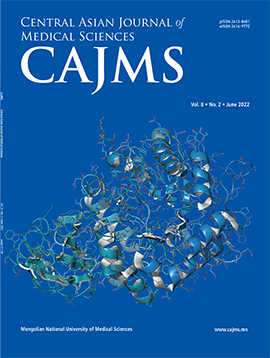Serum Lipid Profile and Its Association with Hypertension among Mongolian Adults
DOI:
https://doi.org/10.24079/cajms.2018.09.006Keywords:
Dyslipidemia, Blood Pressure, Cardiovascular Disease, Gender DifferenceAbstract
Objective: The purpose of this study was to investigate the relationship between serum lipid profile and hypertension among Mongolian adults. Methods: This population-based cross-sectional study was conducted between January and June 2018 in Mongolia. According to current European Society of Cardiology guidelines, hypertension was defined as an average systolic blood pressure ≥140 mmHg and diastolic blood pressure ≥90 mmHg. Lipid profile (total cholesterol (TC), triglycerides (TG), high-density lipid [HDL], cholesterol and low-density lipid [LDL]-cholesterol) and fasting plasma glucose as well as Apolipoprotein B (ApoB), Apolipoprotein A (ApoA) and a ratio of apoB/apoA1 were estimated. Results: This study included 998 participants with a mean age ± SD of 49.4±14.8 years. Serum levels of TC, TG, and LDL were 4.8±0.93, 1.58±1.19 and 3.23±0.9 mmol/L, respectively among males, and 4.5±0.96, 1.22±0.48 and 2.95±1, respectively in females, which were significantly lower (p<0.05). The serum HDL was significantly lower (p<0.01) in males (1.67±0.22mmol/L) than in females (1.85±0.21). Conclusion: The results of this study demonstrate that people with hypertension are more likely have higher dyslipidemia, including elevated TC, TG, LDL and reduced HDL cholesterol level compared to a normotensive group. However, according to the binary logistic regression analysis, the most significant elevations of BP were attributed to age and reduced HDL.
Downloads
231
Downloads
Published
How to Cite
Issue
Section
License
Copyright (c) 2018 Mongolian National University of Medical Sciences

This work is licensed under a Creative Commons Attribution-NonCommercial 4.0 International License.




